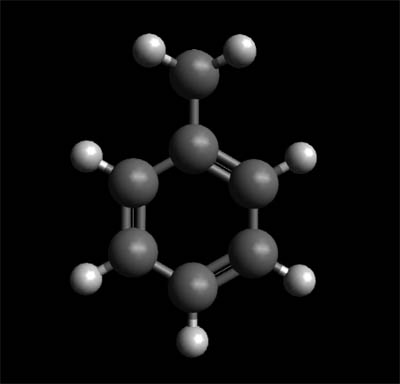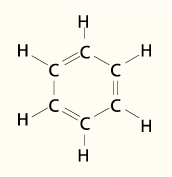The Toluene Molecule

Toluene Molecule - Ball and Stick Configuration
Toluene Molecule using Jsmol see -- For 3D Structures
Toluene also known as toluol, is an aromatic hydrocarbon. It is a colorless, water-insoluble liquid with the smell associated with paint thinners. It is a mono-substituted benzene derivative, consisting of a CH3 group attached to a phenyl group. As such, its IUPAC systematic name is methylbenzene. Toluene is predominantly used in the production of industrial chemicals, fuels, plastics, and pharmaceutical goods and as a solvent. It is used as a solvent in some types of paint thinner, contact cement and model airplane glue. Toluene is toxic but is sometimes used as a recreational inhalent and has the potential of causing severe neurological harm. The compound was first isolated in 1837 through a distillation of pine oil by a Polish chemist named Filip Walter.
Chemical and Physical Properties

Toluene reacts as a normal aromatic hydrocarbon in electrophilic aromatic substitution.[1] Because the methyl group has greater electron-releasing properties than a hydrogen atom in the same position, toluene is more reactive than benzene toward electrophiles. It undergoes sulfonation to give p-toluenesulfonic acid, and chlorination by Cl2 in the presence of FeCl3 to give ortho and para isomers of chlorotoluene. Importantly, the methyl side chain in toluene is susceptible to oxidation. Toluene reacts with Potassium permanganate to yield benzoic acid, and with chromyl chloride to yield benzaldehyde (Étard reaction).
Uses
Toluene is mainly used as a precursor to benzene via hydrodealkylation: C6H5CH3 + H2 → C6H6 + CH4

Benzene Structure
The second ranked application involves its disproportionation to a mixture of benzene and xylene. When oxidized it yields benzaldehyde and benzoic acid, two important intermediates. In addition to the synthesis of benzene and xylene, toluene is a feedstock for toluene diisocyanate (used in the manufacture of polyurethane foam), trinitrotoluene (the explosive, TNT), and a number of synthetic drugs.[2]
As a solvent
Toluene is a common solvent, e.g. for paints, paint thinners, silicone sealants,[3] many chemical reactants, rubber, printing ink, adhesives (glues), lacquers, leather tanners, and disinfectants.[2]
As a Fuel
Toluene can be used as an octane booster in gasoline fuels for internal combustion engines. Toluene at 86% by volume fuelled all the turbocharged engines in Formula One during the 1980s, first pioneered by the Honda team. The remaining 14% was a "filler" of n-heptane, to reduce the octane to meet Formula One fuel restrictions. Toluene at 100% can be used as a fuel for both two-stroke and four-stroke engines; however, due to the density of the fuel and other factors, the fuel does not vaporize easily unless preheated to 70 °C (158 °F). Honda solved this problem in their Formula One cars by routing the fuel lines through a heat exchanger, drawing energy from the water in the cooling system to heat the fuel.[4] In Australia in 2003, toluene was found to have been illegally combined with petrol in fuel outlets for sale as standard vehicular fuel. Toluene incurs no fuel excise tax, while other fuels are taxed at more than 40%, providing a greater profit margin for fuel suppliers. The extent of toluene substitution has not been determined.[22][23] Toluene is one of a group of fuels that have included in jet fuel surrogate blends.[5] Toluene is used as a jet fuel surrogate for its content of aromatic compounds.
Solvent for Fullerene
In the laboratory, toluene is used as a solvent for carbon nanomaterials, including nanotubes and fullerenes, and it can also be used as a fullerene indicator. The color of the toluene solution of C60 is bright purple.
Toxicology
The environmental and toxicological effects of toluene have been extensively studied.[6] . In 2013, worldwide sales of toluene amounted to about 24.5 billion US-dollars [7] Inhalation of toluene in low to moderate levels can cause tiredness, confusion, weakness, drunken-type actions, memory loss, nausea, loss of appetite, hearing loss, and colour vision loss. Some of these symptoms usually disappear when exposure is stopped. Inhaling high levels of toluene in a short time may cause light-headedness, nausea, or sleepiness, unconsciousness, and even death [8]. Toluene is, however, much less toxic than benzene, and has as a consequence, largely replaced it as an aromatic solvent in chemical preparation. The US Environmental Protection Agency (EPA) states that the carcinogenic potential of toluene cannot be evaluated due to insufficient information. [9]
Similar to many other solvents such as 1,1,1-trichloroethane and some alkylbenzenes, toluene has been shown to act as a non-competitive NMDA receptor antagonist and GABAA receptor positive allosteric modulator.[10]
References
1-L. G. Wade, Organic Chemistry, 5th ed., p. 871, Prentice Hall, Upper Saddle RIver, New Jersey, 2003
2- Jörg Fabri, Ulrich Graeser, Thomas A. Simo (2005). "Toluene". Ullmann's Encyclopedia of Industrial Chemistry. Weinheim: Wiley-VCH. doi:10.1002/14356007.a27_147.pub2.
3- Dual cure, low-solvent silicone pressure sensitive adhesives - General Electric Company".
5- Ji, C.; Egolfopoulos, F. N. (2011). "Hydrogen Flame propagation of mixtures of air with binary liquid fuel mixtures". Proc. Comb. Inst. 33: 955–961. doi:10.1016/j.proci.2010.06.085.
6- Hogan, C. Michael (2011), "Sulfur", in Jorgensen, A.; Cleveland, C. J., Encyclopedia of Earth, Washington DC: National Council for Science and the Environment, retrieved 26 October 2012, Sulfur is insoluble in water, but soluble in carbon disulfide, somewhat soluble in other non-polar organic solvents such as the aromatics benzene and toluene.
7- Ceresana. "Toluene – Study: Market, Analysis, Trends - Ceresana".
8- Toluene Toxicity Physiologic Effects", Agency for Toxic Substances and Disease Registry.
9- EPA Toluene Hazard Summary
10- Cruz, S. L.; Soberanes-Chávez, P.; Páez-Martinez, N.; López-Rubalcava, C. (June 2009). "Toluene has antidepressant-like actions in two animal models used for the screening of antidepressant drugs". Psychopharmacology. 204 (2): 279–86.
Molecules of Life Resources